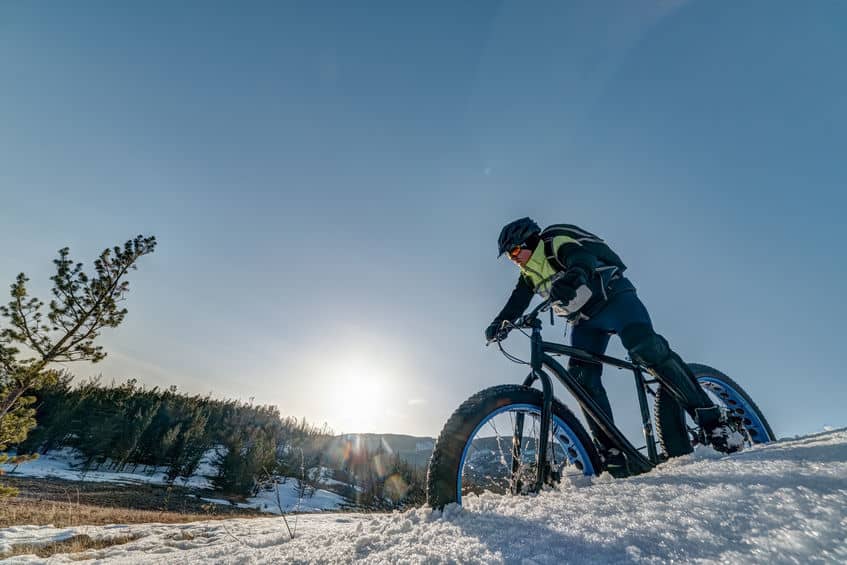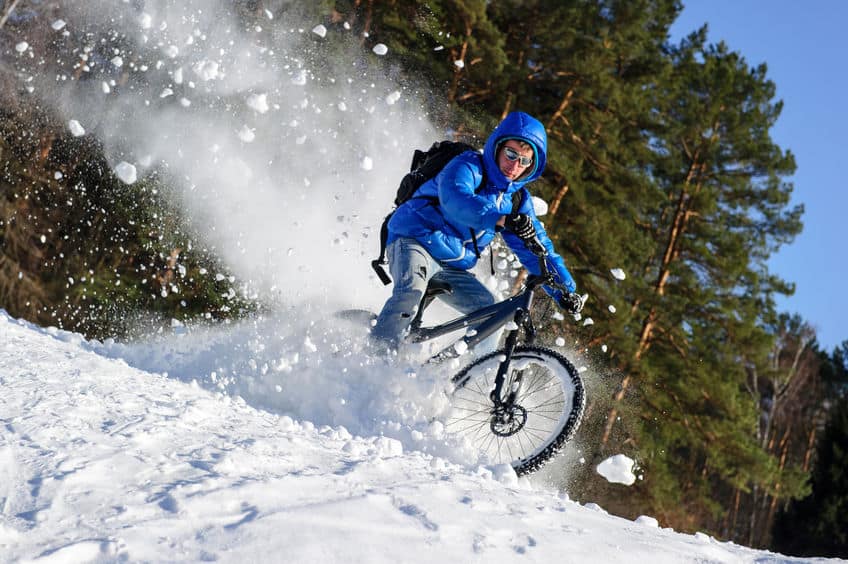Mountain biking is fun for everyone of all ages, and it’s an age-old question of where exactly you can ride your mountain bike. As you go about your cycling, it’s nice to look at all of the beautiful scenery around you, and you start to wonder if there are any other places that you can cycle, other than the regular road.
Can I ride my mountain bike in the snow? Although mountain biking usually takes place on dirt or gravel terrain, it is possible to do it in the snow, but there are additional precautions that must be considered along the way.
There are many things to look out for when you do so, but it is possible to mountain bike after it has snowed. You’ll need to be aware of ice in the way, what equipment you’ll need, and keep in mind your skill set when it comes to mountain biking.
Can I Ride My Mountain Bike In The Snow?
The most important thing to keep in mind before you mountain bike in the snow is if you can mountain bike in the snow. Snowy terrains bring with it a number of complications and obstacles, and it’s important to know if it’s even possible.
The answer is yes and no. While mountain bikes are able to travel in snowy terrains, you need to know your skill set to know if you can handle biking in the snow. If you don’t have the right skill set, it isn’t advisable that you mountain bike in the snow.
Here are some factors to consider before you cycle in the snow:
- Make sure you’re in firm snow
- If the snow is soft, make sure there’s firm ground beneath
- Watch how you’re cycling
- Be observant
- Watch your speed
- Be careful
Firm snow makes it easier to ride, and you don’t have the risk of falling deep into the snow and getting stuck. Even on firm snow, you’re at risk of slipping. Slipping on snow is something you’ll always have to look out for when you’re cycling in the snow.
However, there are some instances where you’re able to ride on softer snow. Some snow that’s soft is incredibly deep, which is why it’s recommended that you don’t bike on it.

But, if you make sure that it isn’t too deep and that there’s firm ground beneath it, then it should be all right to snow in.
Keeping this in mind, however, you’ll want to make sure that you don’t end up too deep in soft snow, or else you will get stuck in the snow. It’s important that you be observant of your surroundings.
Being observant is something that everyone has to keep in mind, but it’s especially important when you’re cycling in snowy terrains. You need to be especially observant about where you’re cycling and if you’re going to sink too deep.
It’s also important to watch out for other obstacles in the way, like trees, pinecones, and the like. If you’re cycling in the street, you’ll need to watch out for cars and other cyclists.
Another thing to be observant of is where you’re cycling because there are some instances where the terrain will change.
Because snow can melt quickly, you’ll want to make sure that the ground ahead of you hasn’t melted overnight or during other parts of the day. If it has, then it’ll be incredibly icy, which brings a risk of crashing your bike.
If you see ice or think that there might be ice ahead, it could be beneficial to brake ahead of time, so that you can judge for yourself whether you should continue biking on that particular road.
Some might be confident enough to bike on ice, but, if you’re new at snowy terrain biking, I wouldn’t recommend that you bike on ice.
You’ll definitely want to make sure that you watch how you’re cycling. The technique is crucial when it comes to mountain biking in the snow.
For starters, you’ll want to make sure that you bike in a straight line and that your bike doesn’t wobble around. How to keep a straight line is to move your body side to side, which will keep your bike tracking.
Another thing to keep in mind is keeping your weight back a bit, as this will keep you more upright and won’t make you fall forward. You don’t want to fall on your face, which would be very painful!
The last thing to keep in mind is being careful. You’re going to have to look out for many things, and you’re going to want to make sure that you execute everything perfectly.
In addition to this, you’re going to want to be gentle with how you’re biking. It doesn’t do to be rough, as you’re bound to crash. So, being gentle with your biking is very important, as well.
What Is Needed Before Riding In The Snow?
As with almost any other outdoor activity, equipment is very, very important for mountain biking in the snow! Making sure that you have the right stuff will guarantee a smoother ride.
There is standard mountain biking equipment, but there is also equipment for riding in the snow, in particular.
But what exactly do you need to make this ride as smooth as possible? And is it necessary?
While a lot of equipment is necessary and important, there is also equipment that will make things easier for you. These tools will make sure that your ride is easier and more fun!
Some of the things you’ll need include:
- Warm clothes
- The right boots
- The right tire
- Emergency equipment
- Food and drink
- Snowshoes
First and foremost, warm clothes are a must. Generally, when it’s been snowing, the air is much, much colder, and you’re going to want to make sure that you’re toasty warm instead of freezing. There are some ways that you can keep extra warm!
Two socks can help keep your feet warm, and you’ll probably want a beanie or something like it to wear under your helmet. This will keep your head warm, too!
You’ll want the right boots, preferably snow boots. Snow boots will help you with traction and will also keep your feet warm. After all, they were made for the snow!
The right tire is very important, as you’re going to want ones that are made for the snow. If they aren’t made for the snow, then you’re bound to slip and fall, which you definitely don’t want!
Emergency equipment, food and drink, and snowshoes are important for when something goes wrong or you want a break. If you do happen to fall and hurt yourself, you’re going to want something that will help you through whatever injury you’ve gotten.
Food and water are there for if you get hungry, and snowshoes are there for if you have to walk through incredibly deep snow.
Tips For Riding In The Snow
There are a lot of ways to prepare for riding in the snow, and it’s important that you do prepare. These tips will focus on before you go out, as you’re going to want to look out for a few things before you go out on your own.
Tips For Riding In The Snow:
- Go in a group
- Talk to someone about what you’re doing
- Use Roads
- Be flexible
Something you should definitely keep in mind is cycling in a group. While you might think that you’ll be fine on your own, cycling in a snowy terrain is much more difficult and it can be easy to get lost. To make sure that you don’t, you’ll have your group with you!
Talking to someone who isn’t going is also important. Tell them where you’re headed, when you’ll be back, and the like.
This way, you won’t be at risk of going out and no one being able to locate you if you do get lost. Once you get back, you’ll want to tell them that you’re home safe and okay.
Use roads! It’s all right if you don’t go completely off road, as off-road is much more dangerous. Roads will make sure that you’re on a safer surface and more people will be able to see you.
Be flexible. Being flexible will help you be prepared for whatever is out there, and you’ll be able to watch out for whatever might come up.
The winter terrain and the like is very different and can change instantly, so you’ll want to be sure that you can adapt to these changes.
Overall, there are a lot of different ways to go about mountain biking in the snow. There are also a lot of different ways to be safe.
Safety is key in situations such as this, and you’re going to want to make sure that you’re as safe as possible.
Keeping all of this in mind and using all of this equipment will help you have a smoother and better ride, and will make sure that things will go right instead of wrong. With that being said, go out there and have fun!

